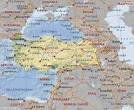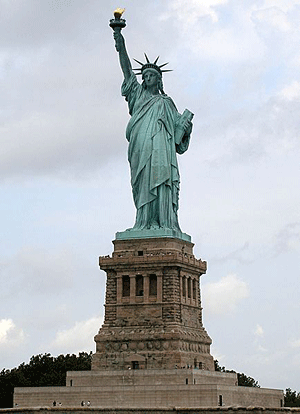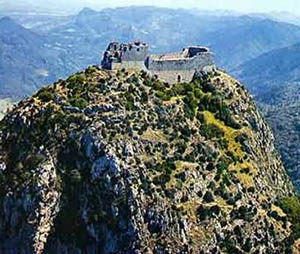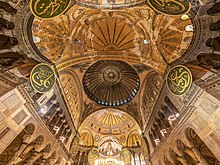|
|
Seven hills of Istanbul
From Wikipedia, the free encyclopedia
Istanbul is known as the City on the Seven Hills (Turkish: Yedi tepeli şehir). The city has inherited this denomination from Byzantine Constantinople which - consciously following the model of Rome - was built on seven hills too.
[edit] The seven hills of Istanbul

Map of Byzantine Constantinople with the hills names in brown
The seven hills, all located in the area within the walls, first appeared when the valleys of the Golden Horn and the Bosphorus were opened up during the Secondary and Tertiary periods. In the Ottoman Age, as in the earlier Byzantine period, each hill was surmounted by monumental religious buildings (churches under the Byzantines, imperial mosques under the Ottomans).
The first hill on which the ancient city of Byzantium was founded, begins from Seraglio Point and extends over the whole area containing Hagia Sophia, the Sultan Ahmed Mosque and Topkapı Palace.
On the second hill are to be found the Nuruosmaniye Mosque, Grand Bazaar and Column of Constantine. The second hill is divided from the first by a fairly deep valley running from Babiali on the east Eminönü.
The third hill is now occupied by the main buildings of Istanbul University, the Bayezid II Mosque to the south and the Süleymaniye Mosque to the north. The southern slopes of the hill descend to Kumkapi and Langa.
The fourth hill on which stood the Church of the Holy Apostles and, subsequently, the Fatih Mosque, slopes down rather steeply to the Golden Horn on the north and, rather more gently, to Aksaray on the south.
On the fifth hill we find the Mosque of Sultan Selim. The fifth and the sixth hills are separated by the valley running down on the west to Balat on the shore of the Golden Horn.
On the sixth hill are to be found the districts of Edirnekapı and Ayvansaray. Its gentle slopes run out beyond the line of the defense walls.
The seventh hill, known in Byzantine times as the Xērolophos (Greek: ξηρόλοφος), or "dry hill," it extends from Aksaray to the Theodosian Walls and the Marmara. It is a broad hill with three summits producing a triangle with apices at Topkapı, Aksaray, and Yedikule.
|

ESTANBUL
ESTAN/ISHTAR
BUL/BULL/TORO
TURKEY = KEY = LLAVE DE DAVID = EXPERIMENTO FILADELFIA
ESTANBUL ES UNA CIUDAD DE 7 COLINAS
TURQUIA ESTA EN EUROPA Y ASIA, OSEA QUE ES UN AGUJERO DE GUSANO= INTERSECCION=VESICA PISCIS
Seven hills of Istanbul
From Wikipedia, the free encyclopedia
Istanbul is known as the City on the Seven Hills (Turkish: Yedi tepeli şehir). The city has inherited this denomination from Byzantine Constantinople which - consciously following the model of Rome - was built on seven hills too.
[edit] The seven hills of Istanbul

Map of Byzantine Constantinople with the hills names in brown
The seven hills, all located in the area within the walls, first appeared when the valleys of the Golden Horn and the Bosphorus were opened up during the Secondary and Tertiary periods. In the Ottoman Age, as in the earlier Byzantine period, each hill was surmounted by monumental religious buildings (churches under the Byzantines, imperial mosques under the Ottomans).
The first hill on which the ancient city of Byzantium was founded, begins from Seraglio Point and extends over the whole area containing Hagia Sophia, the Sultan Ahmed Mosque and Topkapı Palace.
On the second hill are to be found the Nuruosmaniye Mosque, Grand Bazaar and Column of Constantine. The second hill is divided from the first by a fairly deep valley running from Babiali on the east Eminönü.
The third hill is now occupied by the main buildings of Istanbul University, the Bayezid II Mosque to the south and the Süleymaniye Mosque to the north. The southern slopes of the hill descend to Kumkapi and Langa.
The fourth hill on which stood the Church of the Holy Apostles and, subsequently, the Fatih Mosque, slopes down rather steeply to the Golden Horn on the north and, rather more gently, to Aksaray on the south.
On the fifth hill we find the Mosque of Sultan Selim. The fifth and the sixth hills are separated by the valley running down on the west to Balat on the shore of the Golden Horn.
On the sixth hill are to be found the districts of Edirnekapı and Ayvansaray. Its gentle slopes run out beyond the line of the defense walls.
The seventh hill, known in Byzantine times as the Xērolophos (Greek: ξηρόλοφος), or "dry hill," it extends from Aksaray to the Theodosian Walls and the Marmara. It is a broad hill with three summits producing a triangle with apices at Topkapı, Aksaray, and Yedikule.
http://en.wikipedia.org/wiki/Seven_hills_of_Istanbul
|
|
|

luventicus.org
Ankara
596 × 375 - 12k - gif |

voyagesphotosmanu.com
Mapa geográfico de Turquía
575 × 470 - 111k - gif |

viajerosworld.blogspot...
Mapa de Turquia
991 × 642 - 84k - gif |

maps.mygeo.info
Mapa #10 (image/gif)
738 × 380 - 104k - gif |

atlasescolar.com.ar
Turquía
624 × 400 - 76k - gif |

permaculturemarin.org
mapa de turquia y grecia
600 × 371 - 42k - jpg |

whitey.net
Turquía Mapa (Lonely Planet).
400 × 300 - 44k - gif |

consuladodeturquiaenel...
Mapa División Política:
1031 × 599 - 118k - jpg |
|
|
|
|
|
|
|
CONTANTINO NACIO UN 27 DE FEBRERO O 27/2 O 2/27 AMERICANO
|
|
|
|
|
DIANA / ARTEMISA / EFESO (SIETE IGLESIAS DE APOCALIPSIS)
|
|
|
|
|
AÑO DEL QUINTO CENTENARIO DE LA CAIDA DE LOS CATAROS



Statue of Liberty
The height of the Statue of Liberty is 111′-1″ from bottom of foot to top of head. The 7 rays on the crown and the 11 points of the base star echo the proportions of the Great Pyramid’s 7:11 height to base proportion. The superb book Talisman by Graham Hancock and Robert Bauval convincingly shows this goddess is actually the Egyptian Isis.

Image courtesy Elcobbola under the Creative Commons Attribution-Share Alike 3.0 Unported license.
http://www.viewzone.com/onstott66.html

MONTSEGUR VOLCAN/CAN / TEOTIHUACAN / VATICANO / CANA/ AMERICAN/ MEXICAN/ CAN MAYOR (SIRIO)- BODAS DE CANA
Location
Montségur is in the Ariege, in the foothills of the Pyrenees, not far from Lavelanet, due South from Mirepoix.
Montségur lies at 42°52'35" N, 1°49'51" E on a pog (a volcanic pluton) at an altitude of 1,207 meters. The castle is owned by the Commune of Montségur. There is an entrance fee, which also covers entry to a museum in the nearby town.
Guided Tours
Cathar Castle Tours
Mairie: mairie.montsegur@wanadoo.fr
Tel: 05 61 0110 27
Tourist Information Office:
Tel: 05 61 03 03 03


|
|
aerial view of Montségur
|
 |
|
MARIA MAGDALENA EN EL CATARISMO (CATAROS)
25 DE ABRIL=DIA DE SAN MARCOS
22 DE JULIO=DIA DE MARIA LA MAGDALENA
MASON FRANCES
|
|
|
|
|
ISLA SAN GIORGIO (VENECIA)=GEORGE LEMAITRE
Just after midday on July 22, 1946, Zionist terrorists, under the leadership of Menachem Begin, set the fuses on bombs planted in the basement of the King David Hotel in Jerusalem. At 12:37 a huge explosion ripped through the building, killing 91 people. Among the dead were 25 Britons, 41 Arabs, and 17 Jews.
|
|
|
|
|
Hagia Sophia
From Wikipedia, the free encyclopedia
Hagia Sophia (Turkish: Ayasofya; Ancient Greek: Ἁγία Σοφία, romanized: Hagía Sophía; Latin: Sancta Sapientia; lit. 'Holy Wisdom'), officially the Hagia Sophia Grand Mosque (Turkish: Ayasofya-i Kebir Cami-i Şerifi; Greek: Μεγάλο Τζαμί της Αγίας Σοφίας),[3] is a mosque and former church serving as a major cultural and historical site in Istanbul, Turkey. The last of three church buildings to be successively erected on the site by the Eastern Roman Empire, it was completed in AD 537. The site was an Eastern rite church from AD 360 to 1453, except for a brief time as a Latin Catholic church between the Fourth Crusade and 1261.[4] After the fall of Constantinople in 1453, it served as a mosque until 1935, when it became a museum. In 2020, the site once again became a mosque.
The current structure was built by the Byzantine emperor Justinian I as the Christian cathedral of Constantinople for the Byzantine Empire between 532 and 537, and was designed by the Greek geometers Isidore of Miletus and Anthemius of Tralles.[5] It was formally called the Church of God's Holy Wisdom (Greek: Ναὸς τῆς Ἁγίας τοῦ Θεοῦ Σοφίας, romanized: Naòs tês Hagías toû Theoû Sophías)[6][7] and upon completion became the world's largest interior space and among the first to employ a fully pendentive dome. It is considered the epitome of Byzantine architecture[8] and is said to have "changed the history of architecture".[9] The present Justinianic building was the third church of the same name to occupy the site, as the prior one had been destroyed in the Nika riots. As the episcopal see of the ecumenical patriarch of Constantinople, it remained the world's largest cathedral for nearly a thousand years, until the Seville Cathedral was completed in 1520. Beginning with subsequent Byzantine architecture, Hagia Sophia became the paradigmatic Orthodox church form, and its architectural style was emulated by Ottoman mosques a thousand years later.[10] It has been described as "holding a unique position in the Christian world"[10] and as an architectural and cultural icon of Byzantine and Eastern Orthodox civilization.[10][11][12]
The religious and spiritual centre of the Eastern Orthodox Church for nearly one thousand years, the church was dedicated to the Holy Wisdom.[13][14][15] It was where the excommunication of Patriarch Michael I Cerularius was officially delivered by Humbert of Silva Candida, the envoy of Pope Leo IX in 1054, an act considered the start of the East–West Schism. In 1204, it was converted during the Fourth Crusade into a Catholic cathedral under the Latin Empire, before being returned to the Eastern Orthodox Church upon the restoration of the Byzantine Empire in 1261. Enrico Dandolo, the doge of Venice who led the Fourth Crusade and the 1204 Sack of Constantinople, was buried in the church.
After the fall of Constantinople to the Ottoman Empire in 1453,[16] it was converted to a mosque by Mehmed the Conqueror and became the principal mosque of Istanbul until the 1616 construction of the Sultan Ahmed Mosque.[17][18] Upon its conversion, the bells, altar, iconostasis, ambo, and baptistery were removed, while iconography, such as the mosaic depictions of Jesus, Mary, Christian saints and angels were removed or plastered over.[19] Islamic architectural additions included four minarets, a minbar and a mihrab. The Byzantine architecture of the Hagia Sophia served as inspiration for many other religious buildings including the Hagia Sophia in Thessaloniki, Panagia Ekatontapiliani, the Şehzade Mosque, the Süleymaniye Mosque, the Rüstem Pasha Mosque and the Kılıç Ali Pasha Complex. The patriarchate moved to the Church of the Holy Apostles, which became the city's cathedral.
The complex remained a mosque until 1931, when it was closed to the public for four years. It was re-opened in 1935 as a museum under the secular Republic of Turkey, and the building was Turkey's most visited tourist attraction as of 2019.[20]
In July 2020, the Council of State annulled the 1934 decision to establish the museum, and the Hagia Sophia was reclassified as a mosque. The 1934 decree was ruled to be unlawful under both Ottoman and Turkish law as Hagia Sophia's waqf, endowed by Sultan Mehmed, had designated the site a mosque; proponents of the decision argued the Hagia Sophia was the personal property of the sultan. The decision to designate Hagia Sophia as a mosque was highly controversial. It resulted in divided opinions and drew condemnation from the Turkish opposition, UNESCO, the World Council of Churches and the International Association of Byzantine Studies, as well as numerous international leaders, while several Muslim leaders in Turkey and other countries welcomed its conversion into a mosque.
Church of Constantius II
[edit]
 Hagia Sophia, Istanbul, Turkey, ca. 1897.
The first church on the site was known as the Magna Ecclesia (Μεγάλη Ἐκκλησία, Megálē Ekklēsíā, 'Great Church')[21][22] because of its size compared to the sizes of the contemporary churches in the city.[13] According to the Chronicon Paschale, the church was consecrated on 15 February 360, during the reign of the emperor Constantius II (r. 337–361) by the Arian bishop Eudoxius of Antioch.[23][24] It was built next to the area where the Great Palace was being developed. According to the 5th-century ecclesiastical historian Socrates of Constantinople, the emperor Constantius had c. 346 "constructed the Great Church alongside that called Irene which because it was too small, the emperor's father [Constantine] had enlarged and beautified".[25][23] A tradition which is not older than the 7th or 8th century reports that the edifice was built by Constantius' father, Constantine the Great (r. 306–337).[23] Hesychius of Miletus wrote that Constantine built Hagia Sophia with a wooden roof and removed 427 (mostly pagan) statues from the site.[26] The 12th-century chronicler Joannes Zonaras reconciles the two opinions, writing that Constantius had repaired the edifice consecrated by Eusebius of Nicomedia, after it had collapsed.[23] Since Eusebius was the bishop of Constantinople from 339 to 341, and Constantine died in 337, it seems that the first church was erected by Constantius.[23]
 View of the dome interior
        |
|
|
 Primer Primer
 Anterior
64 a 78 de 78
Siguiente Anterior
64 a 78 de 78
Siguiente
 Último
Último

|

